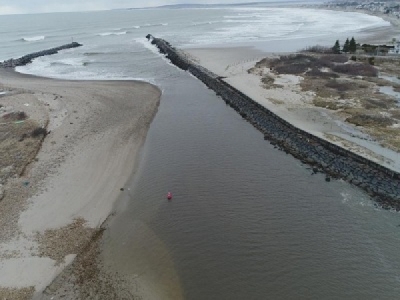
Posted on April 10, 2018
By James Kukstis, Marshfield
Every year, Green Harbor is dredged by the Army Corps of Engineers, with the sediment removed dumped back into the sea off South Marshfield and North Duxbury. This year, thanks to a grant from Massachusetts Coastal Zone Management, the Woods Hole Group will be studying whether this material could be better used replenishing Marshfield’s beaches.
Nearly every summer for the past 20 years, the Army Corps of Engineers has dredged the harbor floor as part of its obligation to maintain the resource as a navigable waterway. Outside sediment and material slowly makes its way into the harbor, reducing the depth and narrowing the harbor’s entrance.
Woods Hole Senior Coastal Geologist Leslie Fields compared the equipment the corps uses to a vacuum cleaner, sucking up the bottom of the harbor and dumping sediment onto a large barge before travelling off shore.
“From a coastal scientist standpoint, that’s something we don’t want to see,” she said. “It’s removing it from the beach system, the near shore system. The beaches in Marshfield are so eroded and we don’t really have a high tide beach there, so in our mind, that process of dredging and taking off shore is robbing the beaches of sand they desperately need.”
To begin to change this process, the Woods Hole Group submitted a grant application last May on behalf of the town to Massachusetts CZM under its Coastal Resiliency Grant program. Marshfield was awarded $36,000, and the town contributed $12,000 on its own, for a feasibility study to determine if this dredging material could be used to replenish the town’s beaches, rather than simply being dumped at sea.
Fields said the study, which will take place this summer, will consider a variety of issues including erosion rates, grain size and the natural sediment characteristics of each beach, existing wetland resources that may be harmed by placing dredging material near it, property ownership, the current directions of sediment transport and the logistical challenges of moving the dredged material to the beaches.
Five permits are required for the actual potential placement of the dredged material; this summer’s study will include a draft of the first.
“Hopefully, next year we can file another grant application to actually file for all the other permits,” Fields said. “Once we have the permits, then that’s really the beauty of the whole thing because the corps is still going to be coming in and dredging, then that makes it a lot more attractive for them to accommodate the town’s desires to get the sand to those beaches.”
The Woods Hole Group will be holding a public meeting at the Ventress Memorial Library on Wednesday, April 11 from 7 to 8:30 p.m. to introduce the project to Marshfield residents.
Source: Marshfield





